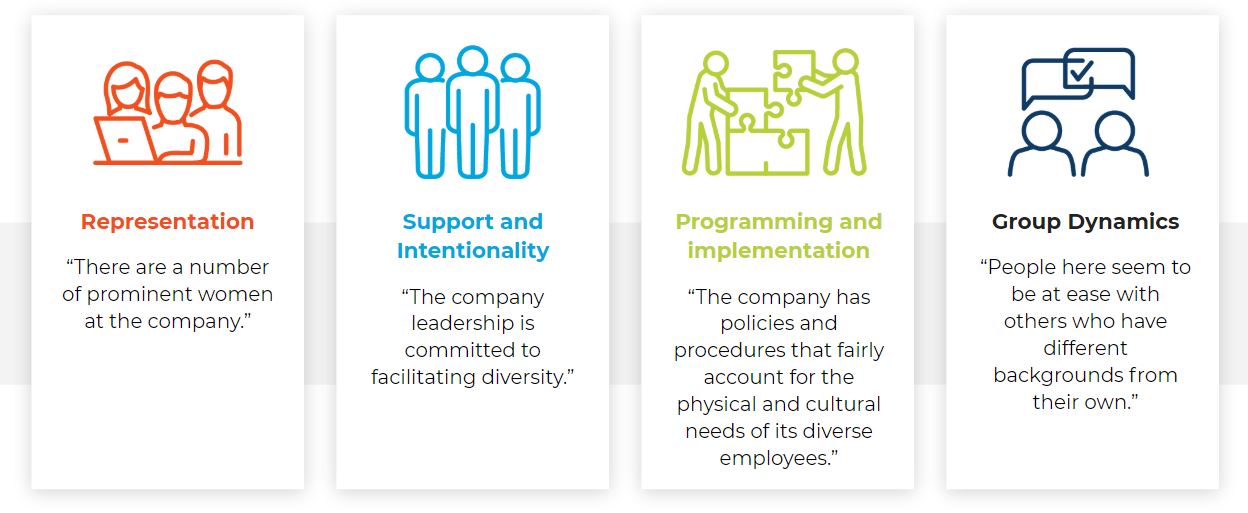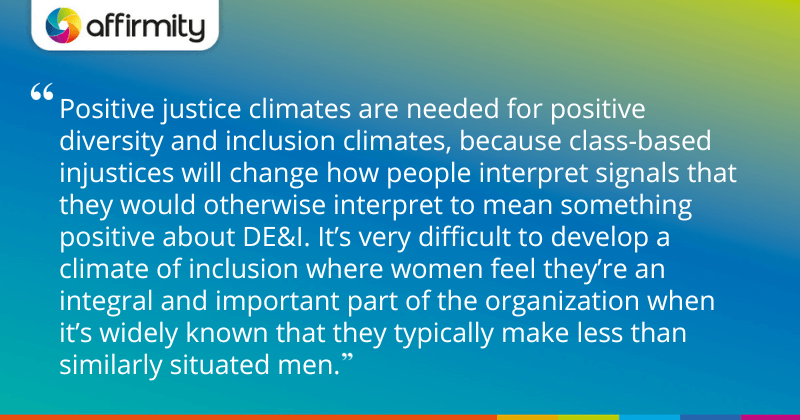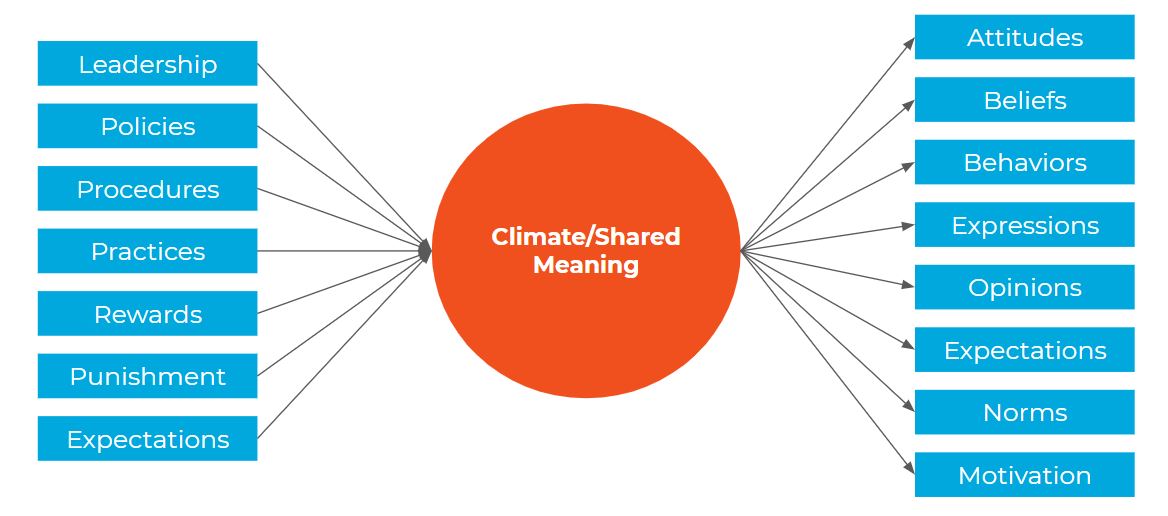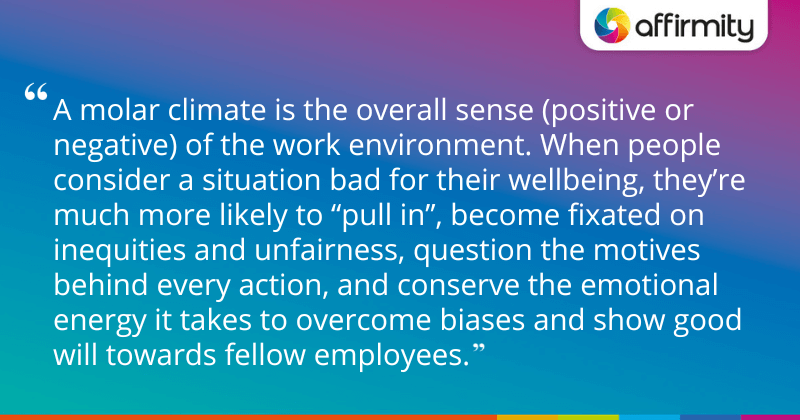Climate surveys can tell you critical information about employee perceptions and the signals your organization is sending. In this article, Principal Consultant Patrick McNiel, PhD explains this powerful analytical tool and how it can be used to understand and evolve your approach to diversity, equity, and inclusion in the workplace. He’ll also consider the example of one Affirmity client and their best-practice suggestions for getting the most out of climate surveys.
What Is Organizational Climate?
Mirroring the way weather patterns in a particular region of the world affect us, we also use the word “climate” to describe the way our social environments generally affect us. When dealing with weather, people exposed to a region’s climate come to understand it, and develop plans, choices, expectations, and lifestyles in accordance with that climate. Additionally, most people will, after developing an understanding of a region’s weather patterns, respond to its climate in similar ways.
Organizations also have social patterns and characteristics that people come to understand, and these characteristics inform how people operate, how they behave, and how they interact with others. They also affect what a person is likely to place importance on, the expectations they form, and how they experience and interpret events.
In this way, different organizations, like different regions, can have very different “climates” which can result in vastly different behavioral patterns.
One widely used, formal definition of organizational climate is: “the shared meaning organizational members attach to the events, policies, practices, and procedures they experience and the behaviors they see being rewarded, supported, and expected.” There have been many definitions of climate, however I think this is the most useful one for organizations to understand, since it includes the link to environmental causes of climate—and it does this while describing climate in the simple terms of shared meaning.
So climate is simply “shared meaning”, and this meaning is derived from all the signals a group of people receives with respect to some area of concern, such as DE&I.
Defining Organizational Climate: Climate Types
Some of the more well-researched areas of organizational concern include:
- Climate for customer service
- Climate for innovation
- Climate for efficiency
- Diversity climate
- Performance climate
These are all “focused” climates, affected by different signals (or lack of signals). In each area, an organization may have a strong, weak, or no climate—this depends on the focus of the organization and the signals being sent within it. The climate can additionally be positive or negative. Organizations generally want to facilitate positive climates if that climate is an area of organizational concern.
Modifying the signals being sent regarding a specific climate starts by understanding the area of concern, examining basic research in that area, and understanding the current conditions within the organization. To do this, organizations should conduct climate surveys that measure both what people are experiencing with respect to salient signals, and whether they have the types of shared understanding or meaning that would result in a positive climate in a particular area.
What Is a Climate for DE&I and How Do You Measure It?
An organization’s climate for DE&I consists of:
- A general climate involving the simple positive or negative feelings toward the organization
- Specific process climates that all work together to either support or hinder diversity, equity, and inclusion goals and aspirations
If measured well, different parts of the configuration can yield rich and targeted information about specific aspects of an organization that are helpful or detrimental to DE&I efforts. They can point to specific areas to address that will maximize the impact of your DE&I efforts.
MORE FROM THIS AUTHOR | ‘Artificial Intelligence: How Are Regulators Responding to the New Tech Frontier for Hiring and HR?’
Diversity Climate

Based on current research and thinking, a diversity climate can be conceptualized as deriving from four main areas.
1) Representation
Do individuals see diversity across jobs and levels and think of the company as diverse? Note that a negative sense of representation can exist even if, on paper, a company has good representation—the visibility of a diversity of individuals also matters.
Typical survey prompt: “There are a number of prominent women at the company.”
2) Support and Intentionality
Do individuals interpret the leadership, their peers, and HR as actively wanting diversity, pushing for it, and supporting it in employees? Many organizations have a stated intention to support diversity, but a negative climate for diversity may still exist if they fail to follow through.
Typical survey prompt: “The company leadership is committed to facilitating diversity.”
3) Programming and Implementation
Do individuals interpret the policies, processes, and procedures at the organization as promoting and supporting diversity? It’s important to assess programs you implement and ensure that they’re interpreted positively and considered fit for purpose.
Typical survey prompt: “The company has policies and procedures that fairly account for the physical and cultural needs of diverse employees.”
4) Group Dynamics
Are those who are from different backgrounds treated with respect, consideration, and fairness? Furthermore, is diversity seen as an asset, and is the prevailing attitude pro-diversity?
Typical survey prompt: “People here seem to be at ease with others who have different backgrounds than their own.”

Inclusion Climate
Inclusion is the degree to which an individual perceives that the group provides him or her with a sense of belonging and authenticity.
1) Belonging
Do people have a sense of warmth when they go to work, do people like each other and make each other feel like they belong, and does the company attempt to make people feel like they belong? Belonging is characterized by a sense of membership and the valence of that membership. So, a person feels they’re in the group and their social interactions are positive.
2) Authenticity
The second area is authenticity: are people allowed to be themselves or do they need to put on a false front at work?
These two aspects of inclusion come from optimal distinctiveness theory (ODT) and self-determination theory (SDT). In short, these theories suggest that belonging and authenticity can be difficult to fully encourage or develop at the same time because they exist in tension with one another.
Perfect belonging would require a person to repress their sense of self in order to subsume themselves within the group—this is the kind of thing you see in cults, rather than businesses. However, perfect authenticity would necessarily require a person’s rejection of all aspects of the group that don’t align with their sense of self, which would create a high degree of disorder and conflict.
Organizations need people to feel like the group values unique aspects of themselves while achieving sufficient alignment among members to develop and maintain a shared identity.
MORE ON INCLUSION | ‘How to Deal With DE&I Naysayers’
Equity Climate
The four main areas of an equity climate are associated with different forms of justice or fairness:
1) Distributive
A distributive justice climate describes the meaning employees share regarding the fairness and equitability of compensation, rewards, or resource distribution.
2) Procedural
A Procedural justice climate describes the meaning employees share regarding the biases and inequality they may see in policies and procedures.
3) Interpersonal
An interpersonal justice climate describes the meaning employees share regarding interpersonal conduct between people, leaders, and employees.
4) Informational
An informational justice climate describes the meaning employees share regarding the distribution and accessibility of information.
Positive justice climates are needed for positive diversity and inclusion climates, because class-based injustices will change how people interpret signals that they would otherwise interpret to mean something positive about diversity and inclusion. For a simple example, it’s very difficult to develop a climate of inclusion where women feel they’re an integral and important part of the organization when it’s widely known that they typically make less than similarly situated men.
Climates That Support a Positive DE&I Climate

In addition to those aspects of climate mentioned above, there are other climates that need to exist in a positive manner at some minimum threshold to enable a positive DE&I climate.
1) Trust
A trust climate is the general sense within a group that people can rely on one another, have each other’s backs, and act with integrity. One of the main reasons diversity, equity, and inclusion are important topics is that humans have tribal natures and tend to divide the world into various ingroups and outgroups. Doing so erodes trust between those groups.
Trust occurs between people when they perceive each other to be on the same side and working toward the same overall goals. Without a positive trust climate, it’s much more difficult for people to be inclusive and to believe in the intentions and actions of leadership with regard to diversity efforts.
2) Molar
A molar climate is the overall sense (positive or negative) of the work environment. A positive molar climate has been shown to increase employee acceptance of efforts to focus on outcomes of value to the organization. Furthermore, when people consider a situation bad for their wellbeing, they’re much more likely to “pull in”, become fixated on inequities and unfairness, question the motives behind every action, and conserve the emotional energy it takes to overcome biases and show good will towards fellow employees.
3) Openness to Experience
An openness to experience climate is one in which new ideas are explored, information is examined, and differences are appreciated or utilized. There’s evidence that a climate for openness to experience may enhance team performance when diversity is a salient factor in teams.
4) Psychological Safety
A psychological safety climate is characterized by the sense that mistakes can be made, risks can be taken, and support can be sought. Research has shown a link between inclusion, psychological safety, and employee engagement.
5) Support
A climate of support is characterized by the sense that leadership cares for employees as well as their job performance, that needed direction, resources, and training will be provided, and that thought will be put into work-life balance issues. The effort, communications, and thought needed to establish such a climate sends signals to employees that their work matters, that they matter, and that the work cannot be done without them.
HANDPICKED FOR YOU | ‘Realistic DE&I Goal Setting: How to Use Data to Get Ahead’

DE&I Climate In Action: MSI’s DE&I Measurement Journey
I recently had the privilege to present on the topic of organizational climate alongside Gwynne Zodrow, Technical Director at Management Systems International (MSI), an international development firm. She provided some fantastic insight into the process of measuring the climate for DE&I with Affirmity, providing a number of best practices in her case study.
MSI is an international development firm. Its services include providing monitoring and evaluation support to the US government’s overseas programs. Shortly after forming an internal DE&I council, MSI became interested in measuring progress on its DE&I climate. Though the organization has a lot of experience in administering surveys and measuring results, it opted to engage Affirmity because it was felt a third-party perspective was needed due to the sensitivity of the topic.
Ms Zodrow made the following best-practice recommendations:
1) Define Your Objectives
Before bringing Affirmity on board, MSI had already crafted a results framework delineating its DE&I objectives. It had also developed indicators aligned with these objectives to help it measure and track progress.
2) Tailor Tools to Your Organization
MSI ensured that the measurement tools used were tailored to the organization’s unique needs and aligned with its areas of interest. Ms Zodrow provided an inside view of MSI’s strengths and weaknesses and knew which areas would be important to focus on. She was able to collaborate closely with Affirmity to develop the tool to account for this insight.
The questions you ask should also be tailored to your organization. In MSI’s case, finding the right balance of close-ended and open-ended questions was particularly important: incorporating open-ended questions following certain close-ended questions allowed it to gather more nuanced information about key focus areas and certain weaknesses. This also kept data collection relevant, maintaining data quality without burdening staff with a lengthy survey.
3) Engaging Leadership to Ensure Buy-In
It’s crucial to involve leadership in the process. For MSI, this involved including them in the review of the tools and in the process of drafting a DE&I framework and indicators. Early buy-in ensures that when you deliver your findings, it’ll be easier to take action on the decisions that need to be made.
4) Communicate the Importance of the Study
Prior to launching its survey, MSI announced its initiative during bi-weekly all-staff meetings, and it sent out several emails to explain the process and objectives. It also made sure to communicate the data confidentiality protocols it had in place in order to put minds at ease and maximize participation.
5) Review, Digest, and Discuss Your Findings
After the climate survey is completed, you’ll need to thoroughly review the data, analyze the information, and engage in discussions at the leadership level. Affirmity provided a full report, and MSI took time to also review the qualitative responses it received, in order to fully understand staff feedback. Leadership convened multiple times to discuss the findings and its response.
6) Disseminate Your Findings and Commit to Actions
MSI invited Affirmity to present the key insights from the report during an all-staff meeting, and staff had the opportunity to ask questions during the session. MSI’s president then addressed the staff and outlined leadership’s plans to address the findings, with long- and short-term goals, as appropriate. This ensured accountability, and let the staff know that leadership was committed to addressing the findings.
7) Maintain Transparency Going Forward
In order to maintain the momentum gained by communicating plans, organizations must commit to regularly updating employees on plans and progress. This ongoing communication is something MSI continues to prioritize and improve upon as it builds trust with staff and shows that leadership acknowledges issues and is committed to making the necessary changes to address them.
If you’re ready to begin creating your own D&I climate investigations, contact us to talk to an expert today.
About the Author
 Patrick McNiel, PhD, is a principal business consultant for Affirmity. Dr. McNiel advises clients on issues related to workforce measurement and statistical analysis, diversity and inclusion, OFCCP and EEOC compliance, and pay equity. Dr. McNiel has over ten years of experience as a generalist in the field of Industrial and Organizational Psychology and has focused on employee selection and assessment for most of his career. He received his PhD in I-O Psychology from the Georgia Institute of Technology. Connect with him on LinkedIn.
Patrick McNiel, PhD, is a principal business consultant for Affirmity. Dr. McNiel advises clients on issues related to workforce measurement and statistical analysis, diversity and inclusion, OFCCP and EEOC compliance, and pay equity. Dr. McNiel has over ten years of experience as a generalist in the field of Industrial and Organizational Psychology and has focused on employee selection and assessment for most of his career. He received his PhD in I-O Psychology from the Georgia Institute of Technology. Connect with him on LinkedIn.
